Eclectic interior design is a highly personalized and artistic approach that celebrates the harmony of contrasts. It involves thoughtfully curating a mix of styles, time periods, textures, and colors to create a space that is cohesive yet uniquely individual. Unlike other design styles with strict rules, eclecticism is about freedom and storytelling, where every object has a place and a purpose. This approach allows you to showcase your personality by blending old with new,East with West, and luxe with humble. The key is finding a common thread—be it color, shape, or finish—that ties the disparate elements together.
1. Merging Vintage Furnishings with Modern Silhouettes

A cornerstone of eclectic design is the artful fusion of furniture from different eras. To achieve this, consider placing a sleek, contemporary sofa alongside ornate, vintage Victorian armchairs. The juxtaposition creates a dynamic visual tension that is both surprising and delightful. This approach works by allowing each piece to highlight the unique qualities of the other—the clean lines of modern design emphasize the intricate details of the antique pieces, and vice versa. A common color palette or a shared material, like wood, can serve as the unifying element that bridges the stylistic gap and ensures the room feels intentionally curated.
2. Layering Rugs with Divergent Patterns and Textures

Take your flooring from a simple foundation to a focal point by layering multiple rugs. This technique adds depth, warmth, and a rich textural quality to any room. Start with a large, neutral base rug, such as a sisal or jute, to define the space. Then, layer smaller, more vibrant rugs on top. For a truly eclectic feel, don't be afraid to mix patterns—a geometric print over a traditional Persian rug or a cowhide atop a flatweave can create a stunning effect. The key is to ensure the color palettes of the rugs have at least one shared hue to create a sense of harmony.
3. Assembling a Gallery Wall with Mixed Media Art
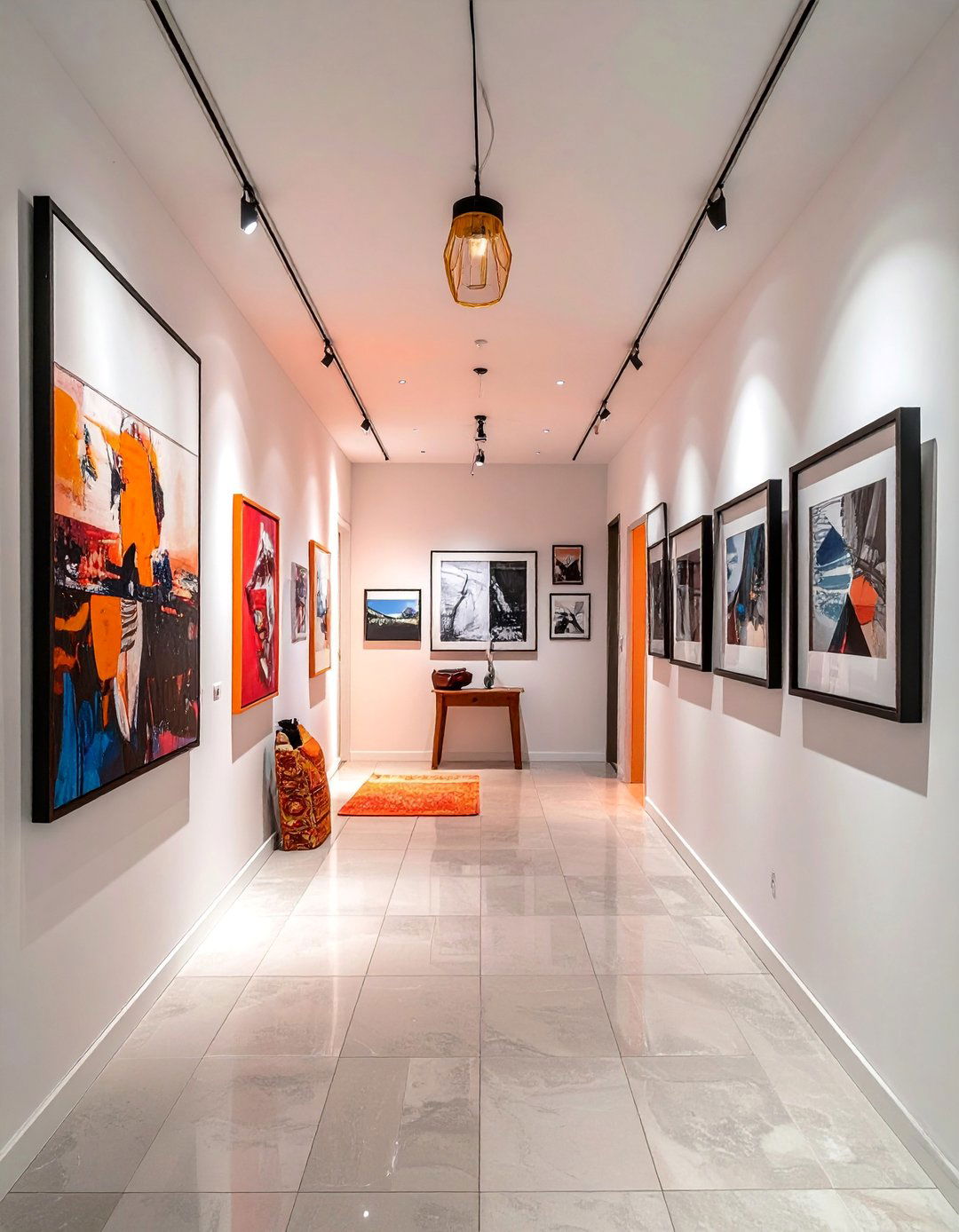
Create a powerful statement by dedicating a wall to a collection of diverse art and objects. An eclectic gallery wall moves beyond uniform frames and prints, incorporating a mix of paintings, photographs, sketches, mirrors, and even three-dimensional items like small sculptures or woven textiles. Vary the sizes, shapes, and styles of the frames to enhance the collected-over-time aesthetic. Arrange the pieces on the floor first to find a balanced composition before hanging them. This personal mosaic not only adds character but also serves as a visual narrative of your tastes, travels, and memories, making the space uniquely yours.
4. Employing an Unexpected and Bold Color Palette
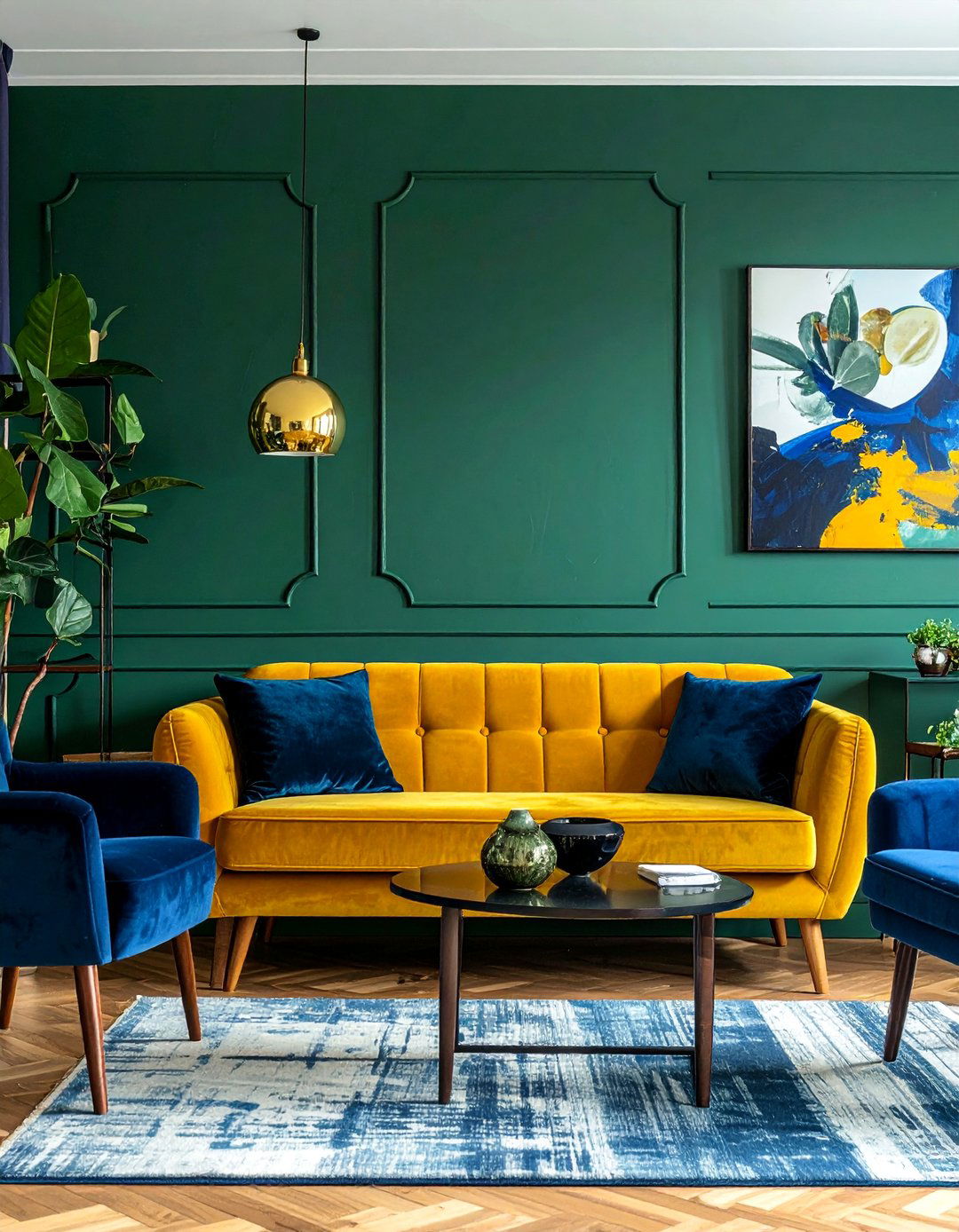
While many design styles stick to a limited color scheme, eclectic design thrives on bold and unexpected combinations. Think deep jewel tones like emerald green paired with vibrant mustard yellow, or a soft blush pink contrasted with a striking navy blue. The trick to making it work is to follow the 60-30-10 rule: 60% of the room should be a dominant color, 30% a secondary color, and 10% an accent. This structure provides balance and prevents the bold choices from overwhelming the space. Use these colors across furniture, textiles, and wall paint to create a cohesive yet daring environment that feels full of energy.
5. Juxtaposing Contrasting Textures for Sensory Depth

An eclectic space engages more than just the eyes; it's also about the sense of touch. To create this tactile experience, combine a variety of materials with different textures. Imagine a rough, reclaimed wood coffee table topped with smooth, polished metal decor, or a sleek leather sofa adorned with chunky knit and soft velvet throw pillows. The contrast between hard and soft, rough and smooth, adds a layer of complexity and comfort to the room. This interplay of textures makes the space feel more dynamic and inviting, encouraging you to interact with your surroundings and appreciate the richness of the design.
6. Incorporating Global Accents and Travel Souvenirs
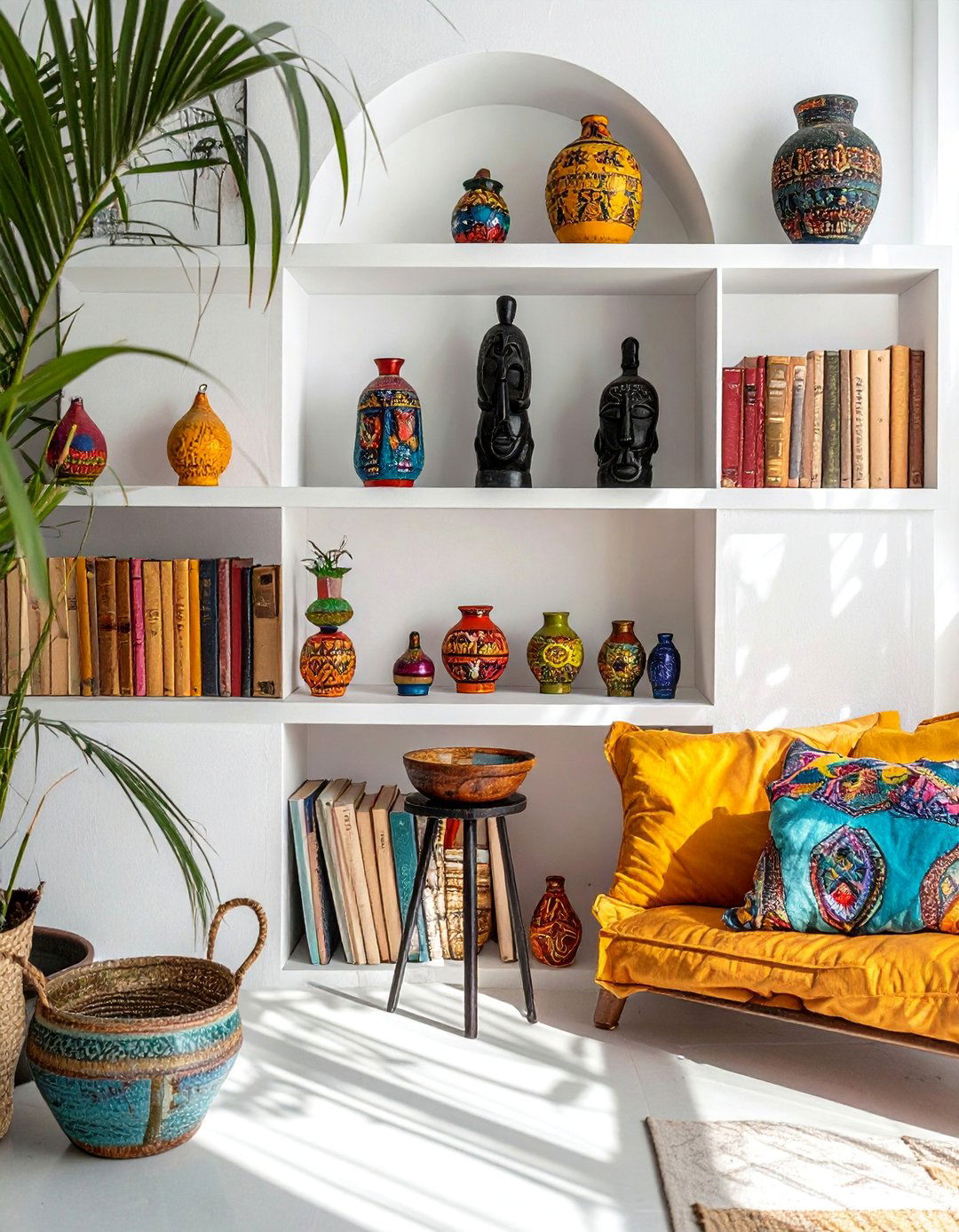
Weave stories of your travels into your decor by showcasing items from around the world. Eclectic design is the perfect canvas for displaying global finds, such as Moroccan lanterns, Japanese ceramics, or handwoven textiles from South America. These pieces add a layer of personal history and cultural richness to your space. Instead of hiding souvenirs away, integrate them thoughtfully into your design. A carved African mask can become a piece of wall art, while a collection of small Russian nesting dolls can add a whimsical touch to a bookshelf. These worldly elements ensure your home is a true reflection of your life's adventures.
7. Using a Cohesive Neutral Backdrop for Eclectic Decor
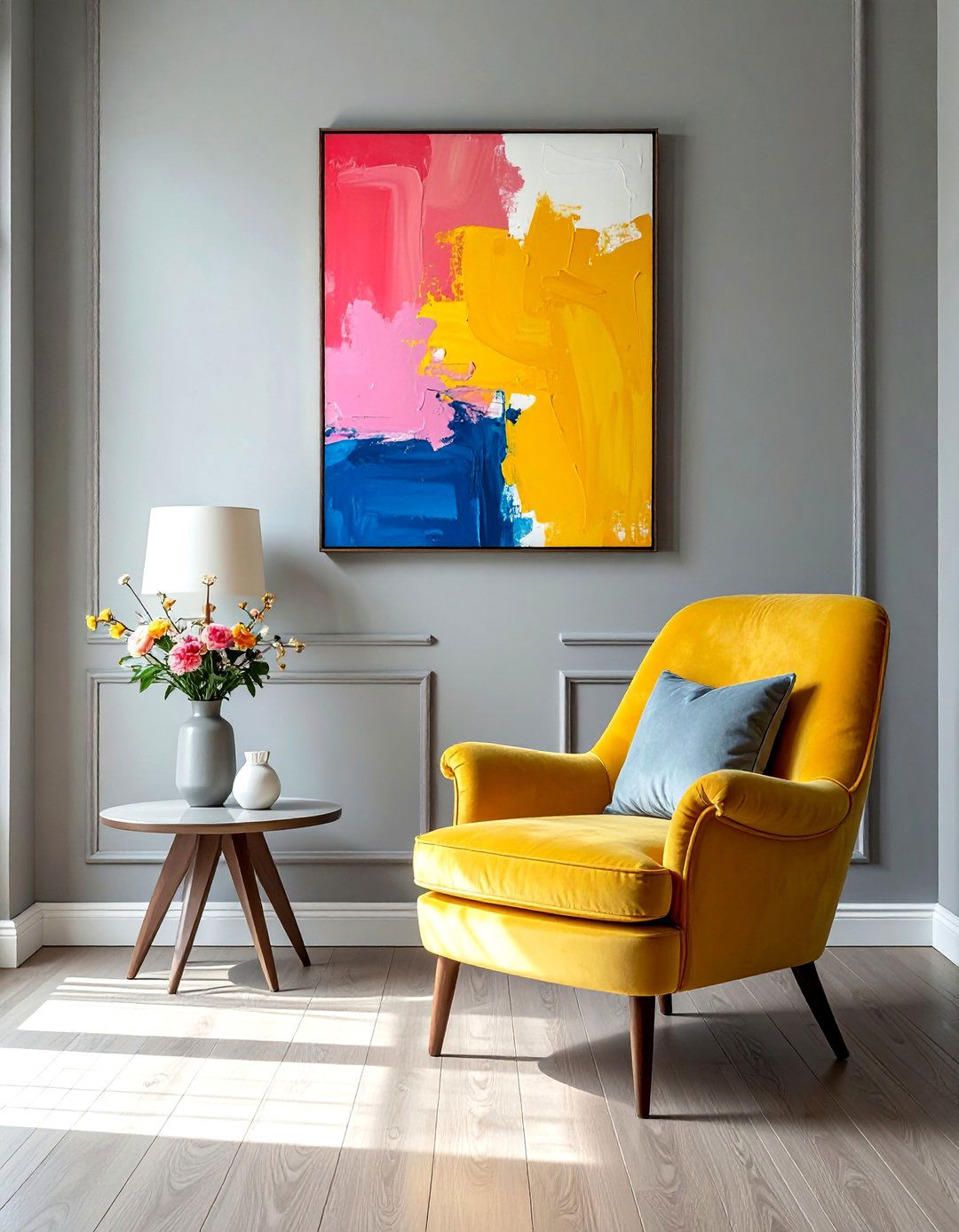
To prevent a collection of diverse objects from feeling chaotic, anchor your space with a neutral backdrop. Walls painted in soft white, muted gray, or warm beige create a calm canvas that allows your unique furniture and decor to take center stage. This approach ensures that your statement pieces—like a brightly colored armchair or a gallery wall of vibrant art—can shine without competing with their surroundings. The neutral walls provide visual breathing room, helping to unify the different styles, colors, and textures within the room. This balance between a quiet background and expressive foreground is key to a sophisticated eclectic look.
8. Balancing Asymmetrical Decor with a Symmetrical Layout
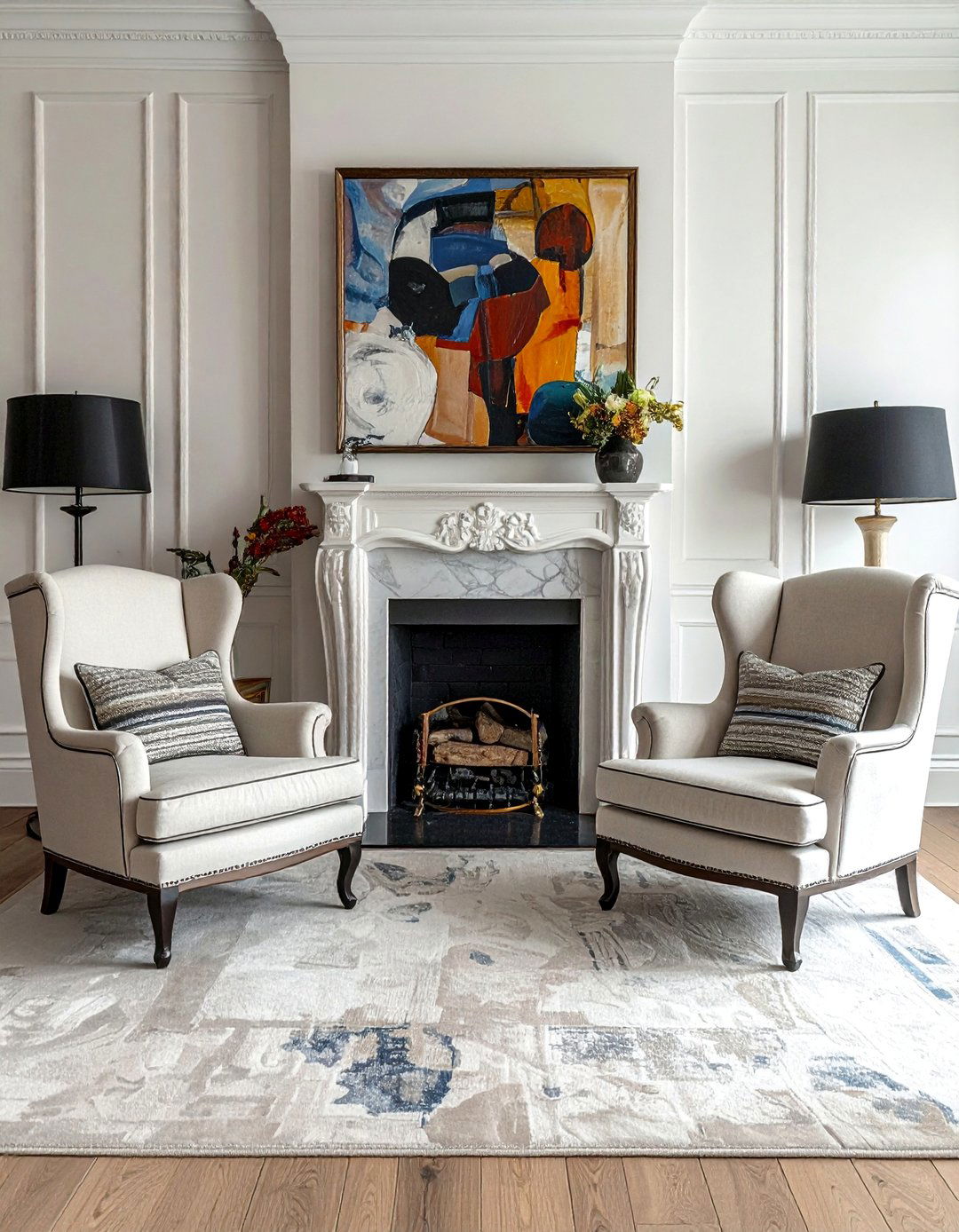
Create a sense of underlying order in an eclectic room by arranging furniture in a symmetrical layout. Placing two matching sofas opposite each other or flanking a fireplace with identical bookshelves provides a structured foundation. Upon this balanced base, you can then layer asymmetrical and diverse decorative elements. For instance, you could place different-style end tables beside each sofa or hang a varied collection of art above the mantelpiece. This method provides the best of both worlds: the calm and order of symmetry combined with the personality and visual interest of eclecticism, resulting in a space that feels both grounded and free-spirited.
9. Installing a Statement Lighting Fixture as a Focal Point

A dramatic lighting fixture can act as the central jewel in an eclectic room, tying all the disparate elements together. Choose a piece that defies easy categorization—perhaps a massive, ornate crystal chandelier hanging in a room with minimalist furniture, or a spiky, mid-century modern Sputnik light above a traditional dining table. This single, bold choice can define the space and establish its adventurous tone. The light fixture becomes a functional sculpture, drawing the eye upward and providing a powerful focal point that anchors the room's diverse collection of furnishings and decor, proving that eclectic design is all about confident, deliberate choices.
10. Repurposing Everyday Objects into Unique Decor Pieces
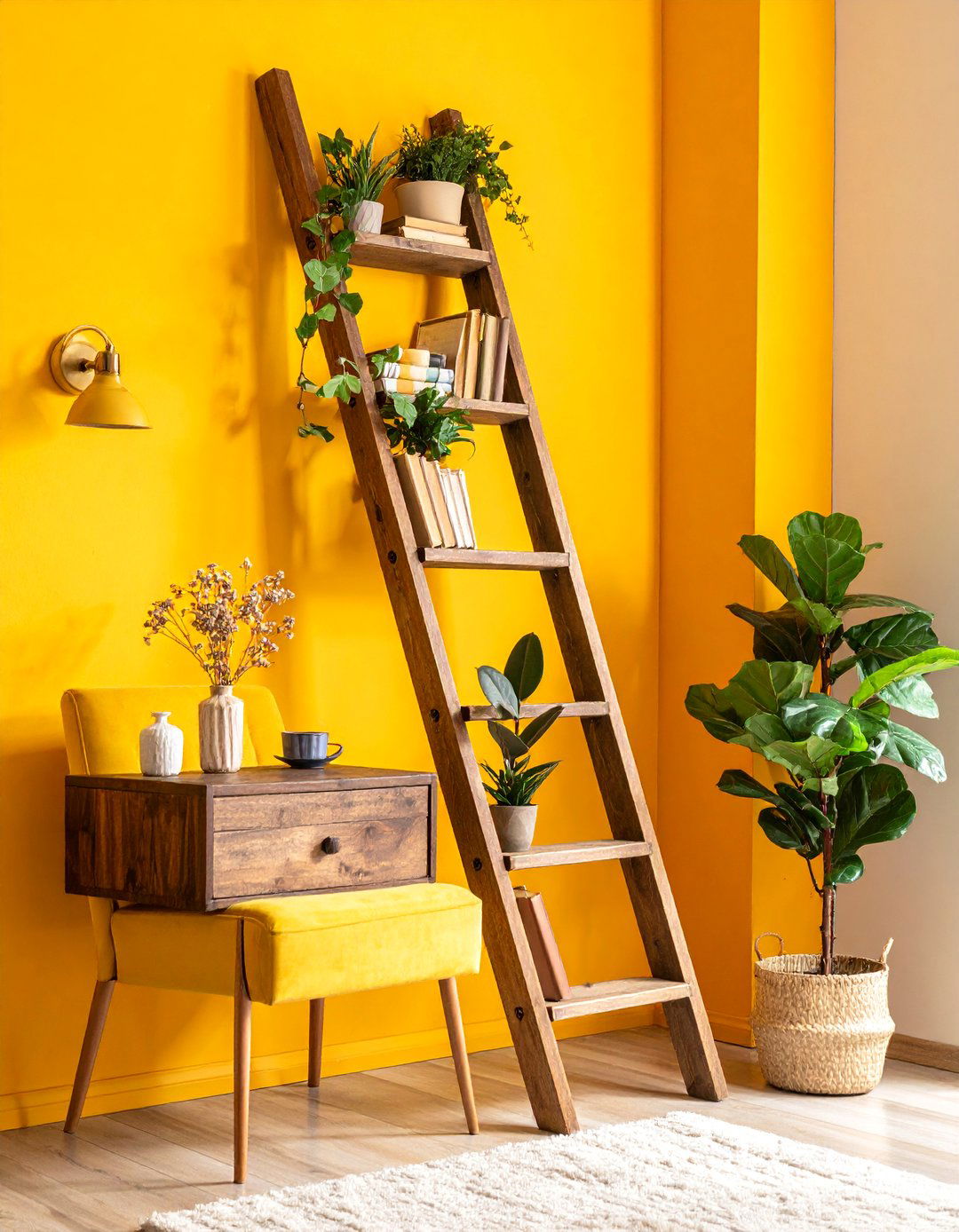
Eclectic interior design celebrates creativity and ingenuity, making it the perfect style for giving old objects new life. Look beyond traditional decor and consider how everyday items can be repurposed. An old wooden ladder can be transformed into a unique bookshelf, a stack of vintage suitcases can become a charming end table, or a collection of antique teacups can be mounted on the wall as art. This approach not only adds a personal and whimsical touch to your space but is also a sustainable way to decorate. It ensures your home is filled with one-of-a-kind pieces that have a story to tell.
11. Infusing Eclectic Style with Raw Industrial Elements
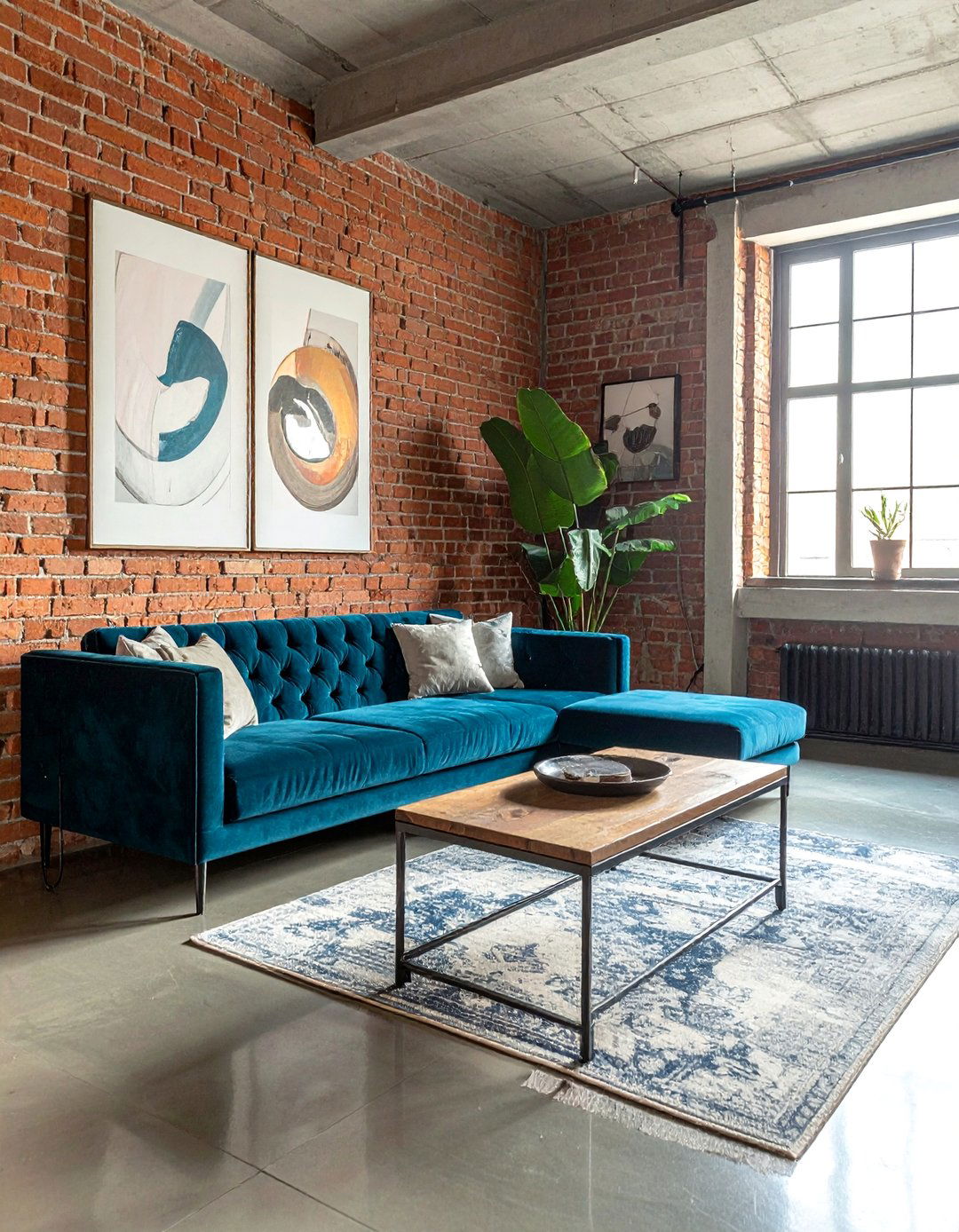
Blend the curated nature of eclectic design with the raw, unfinished aesthetic of industrial style. This combination creates a space that feels both artistic and authentic. Pair plush, upholstered furniture with exposed brick walls, or place a refined art collection in a room with visible ductwork and polished concrete floors. The contrast between soft textiles and hard materials, or between elegant decor and utilitarian architecture, generates a compelling visual dialogue. Elements like metal factory carts used as coffee tables or salvaged warehouse windows repurposed as mirrors can further enhance this edgy yet sophisticated look, adding a layer of urban grit to your eclectic mix.
12. Cultivating a Bohemian Vibe within an Eclectic Framework

The free-spirited, relaxed nature of bohemian style blends seamlessly with the principles of eclectic design. To achieve this look, focus on natural materials, earthy colors, and a wealth of textures. Incorporate items like rattan furniture, macrame wall hangings, and an abundance of houseplants. Layer patterned textiles, such as kilim rugs and embroidered pillows, to create a cozy and inviting atmosphere. Unlike a purely bohemian space, an eclectic-boho room might also feature a sleek, modern sofa or a piece of abstract art. This fusion results in a space that feels both well-traveled and deeply personal, capturing a carefree yet curated aesthetic.
13. Adopting a Minimalist Approach to Eclectic Curation

Eclectic design doesn't have to mean maximalist clutter. You can embrace its principles within a minimalist framework by focusing on a few carefully chosen, high-impact pieces. This style, often called "curated eclecticism," is about making every item count. Start with a clean, uncluttered space and a restrained color palette. Then, introduce a small selection of objects from different styles and eras, such as a mid-century modern chair, an antique Persian rug, and a contemporary abstract painting. Each piece is given ample negative space to be appreciated on its own, creating a sophisticated and intentional look that is both personal and serene.
14. Designing Eclectic Kitchens with Mismatched Cabinetry
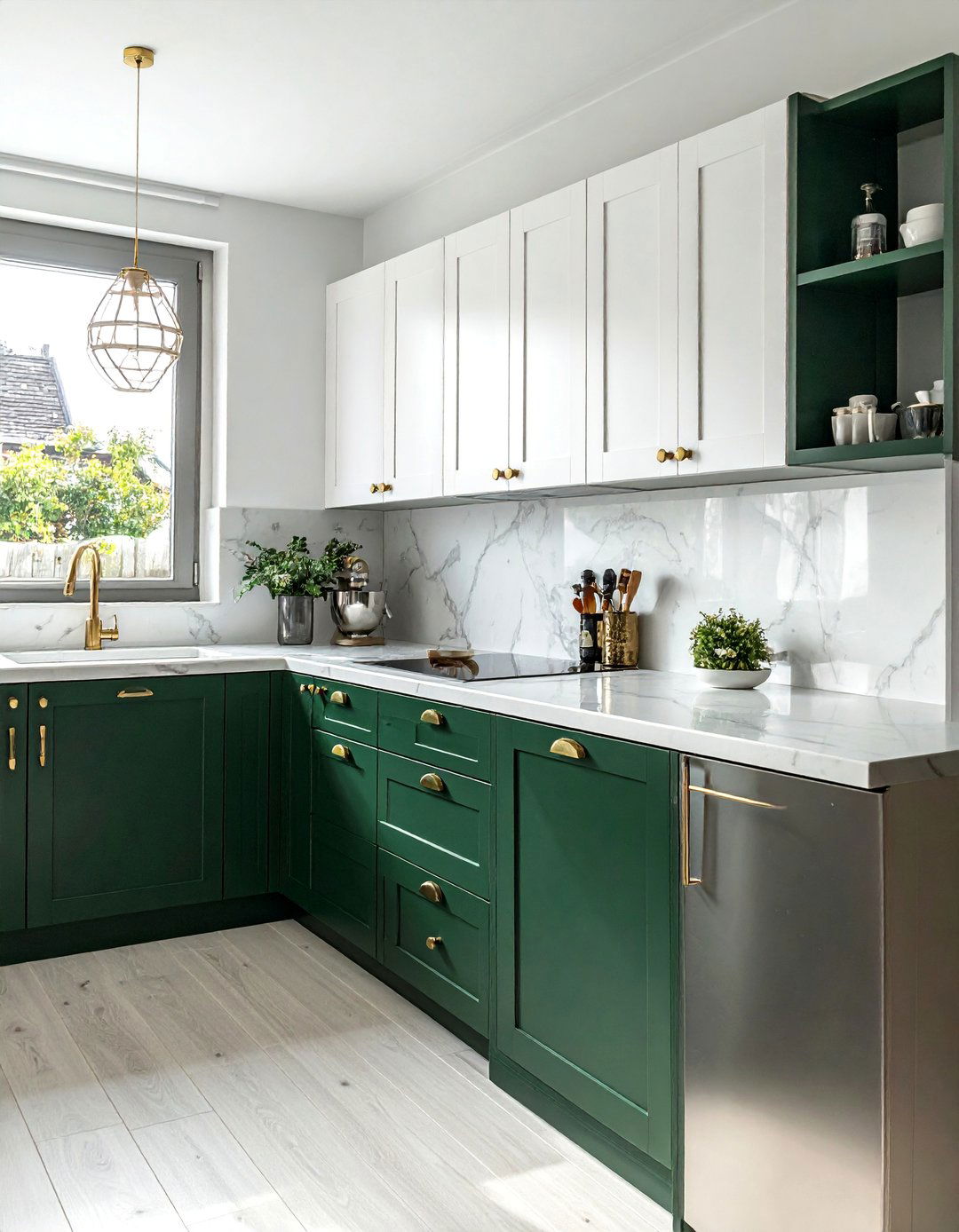
Bring the eclectic spirit into the heart of the home by designing a kitchen with mismatched elements. Move away from uniform cabinetry by mixing different colors, materials, or door styles. For example, you could pair sleek, handleless upper cabinets in a crisp white with rustic, reclaimed wood lower cabinets. Another idea is to paint the island a bold, contrasting color that stands out from the perimeter cabinetry. This approach adds instant character and a custom-built feel to the kitchen. Unify the look with consistent hardware, countertops, or a cohesive backsplash to ensure the space feels intentionally designed rather than disjointed.
15. Crafting Eclectic Bedrooms with Personal Collections
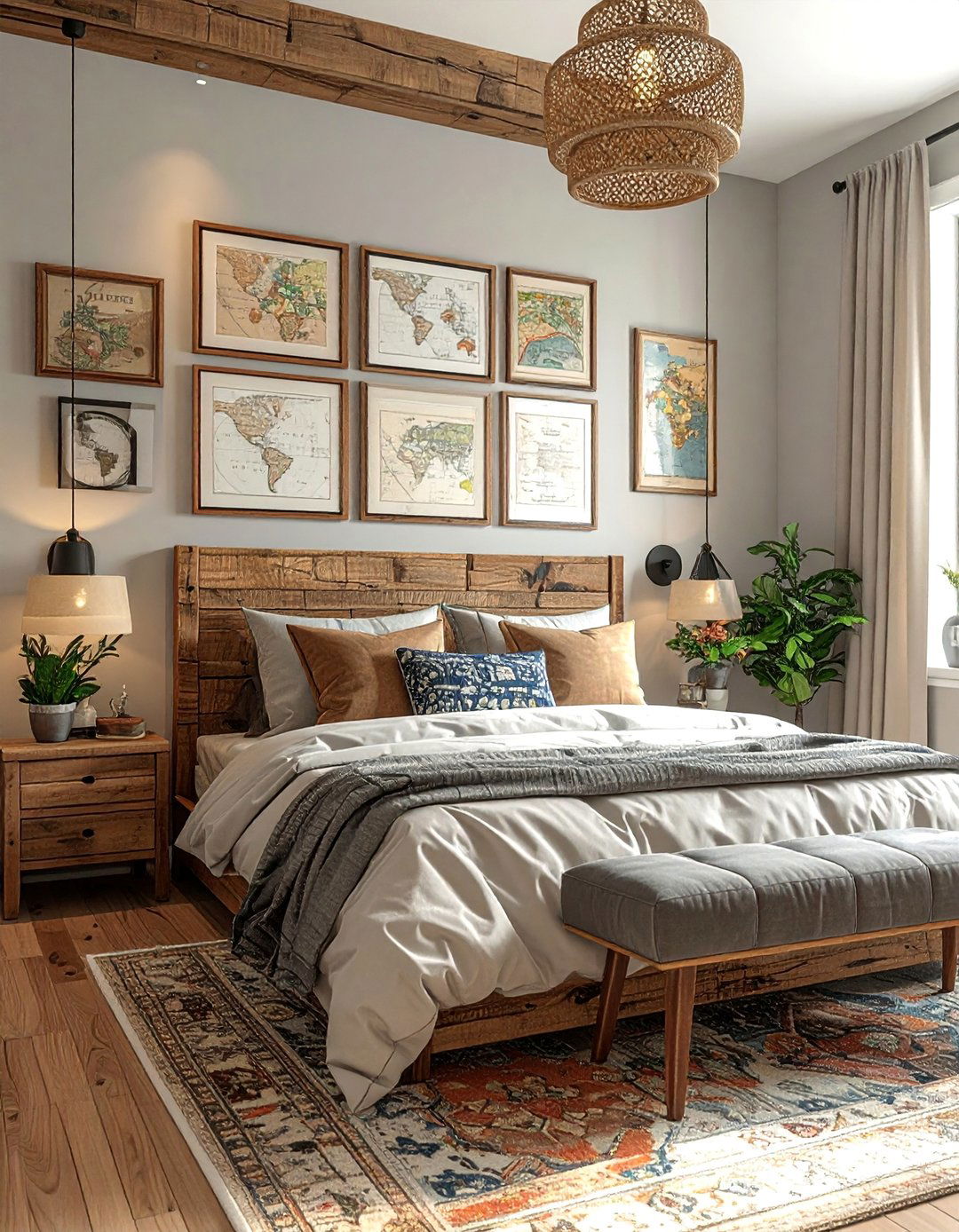
Your bedroom is the most personal space in your home, making it the ideal setting for an eclectic design that showcases your identity. Use it as a canvas to display your personal collections, whether it's vintage hats, antique maps, or a curated selection of your favorite books. Arrange these items on open shelving, in display cases, or as part of a gallery wall above the headboard. Mix these collections with furniture and textiles from various styles—a rustic wooden bed frame with silk pillows or a modern lamp on an antique nightstand. This deeply personal approach turns your bedroom into a sanctuary that tells your unique story.
16. Utilizing Books as a Prominent Design Element
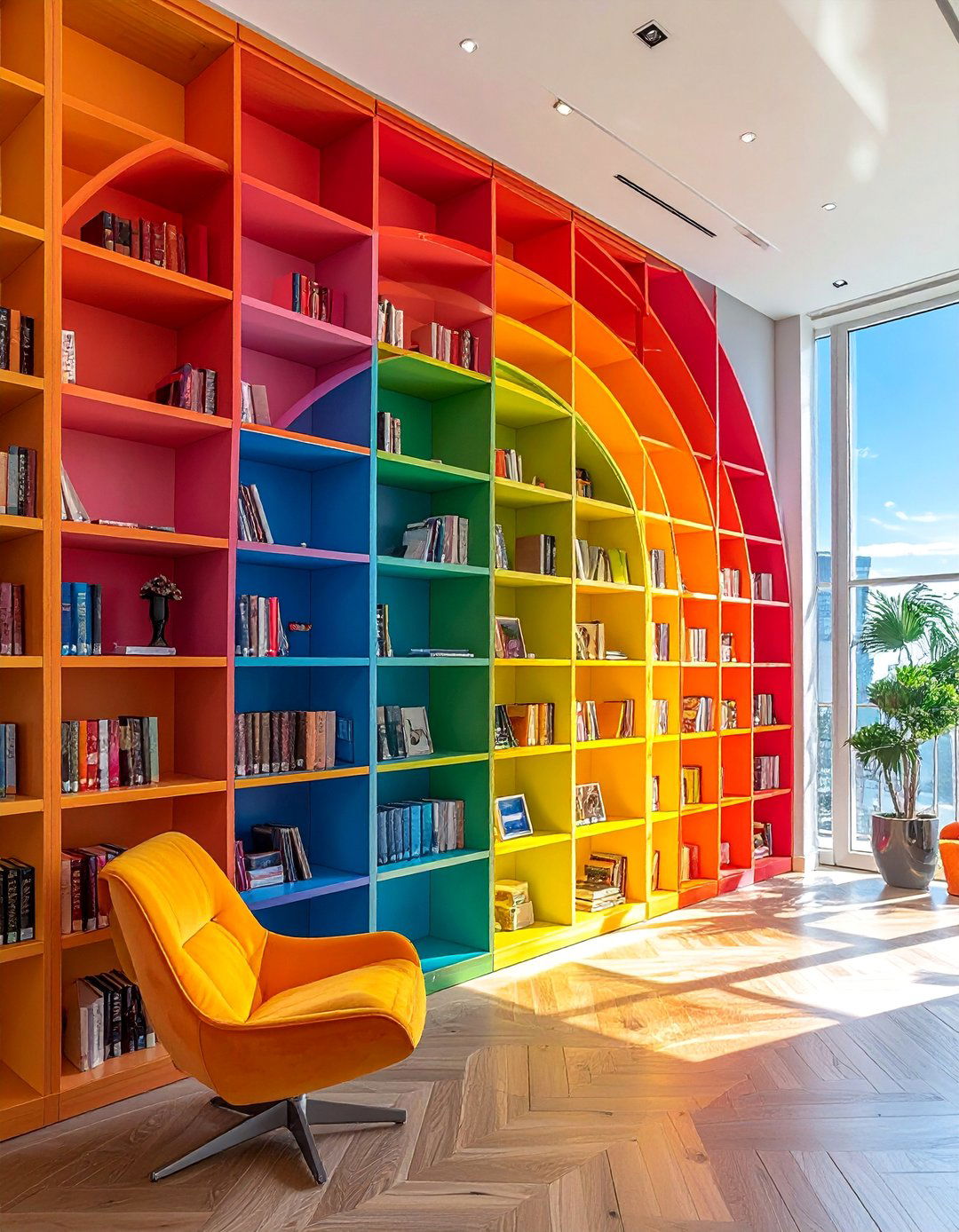
For the literary lover, books can be more than just reading material—they can be a central feature of your eclectic decor. Instead of hiding them away, use books to add color, texture, and personality to your space. Arrange them on shelves not just vertically but also in horizontal stacks to create visual interest and serve as pedestals for small decorative objects. You can also organize them by color to create a rainbow effect that becomes a piece of art in itself. A towering, floor-to-ceiling bookshelf filled with a diverse collection of volumes creates a powerful backdrop that speaks to a curious and well-read mind.
17. Mixing Different Metallic Finishes for a Curated Sheen
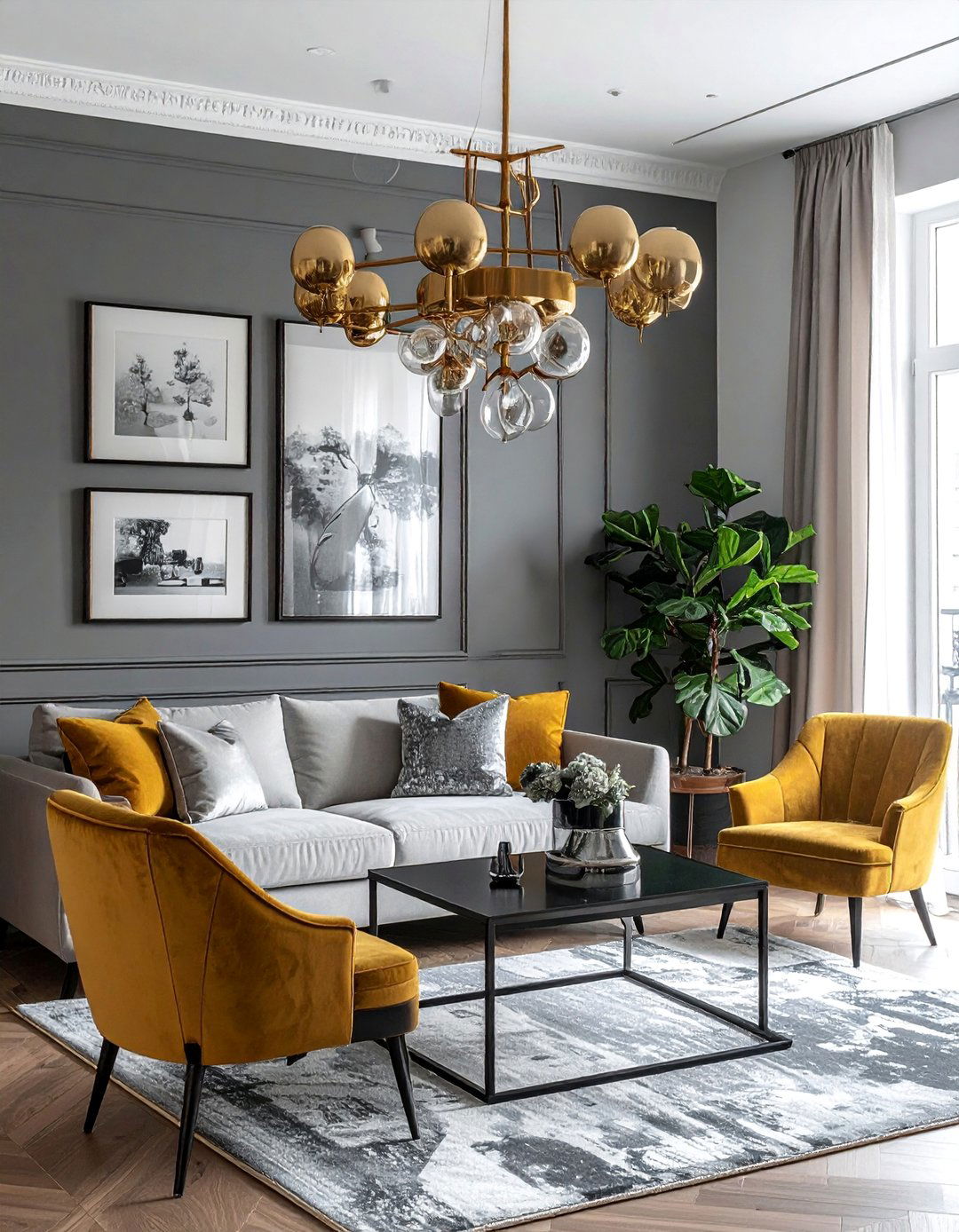
Gone are the days of sticking to a single metallic finish. A key element of modern eclectic design is the artful mixing of metals like gold, silver, brass, copper, and matte black. This layered approach adds a touch of glamour and sophistication. To do it successfully, choose one dominant metal and use others as accents. For example, you might have a large brass chandelier, complemented by silver picture frames and black cabinet hardware. Spreading the different finishes throughout the room helps create a cohesive flow. This technique gives the space a collected-over-time feel, as if each piece was acquired thoughtfully and individually.
18. Integrating Large-Scale Plants and Abundant Botanicals

Bring life and organic texture into your eclectic space with the generous use of houseplants. Go beyond a few small pots on a windowsill and think bigger. A large, sculptural fiddle-leaf fig tree or a dramatic monstera can act as a living work of art, adding a vibrant splash of green and softening the lines of furniture and architecture. Group plants of various sizes and leaf shapes together to create a lush, jungle-like corner. The natural, untamed feel of botanicals provides a beautiful contrast to the curated collection of furniture and art, reinforcing the eclectic blend of styles.
19. Combining Wallpaper and Textiles in a Pattern Play
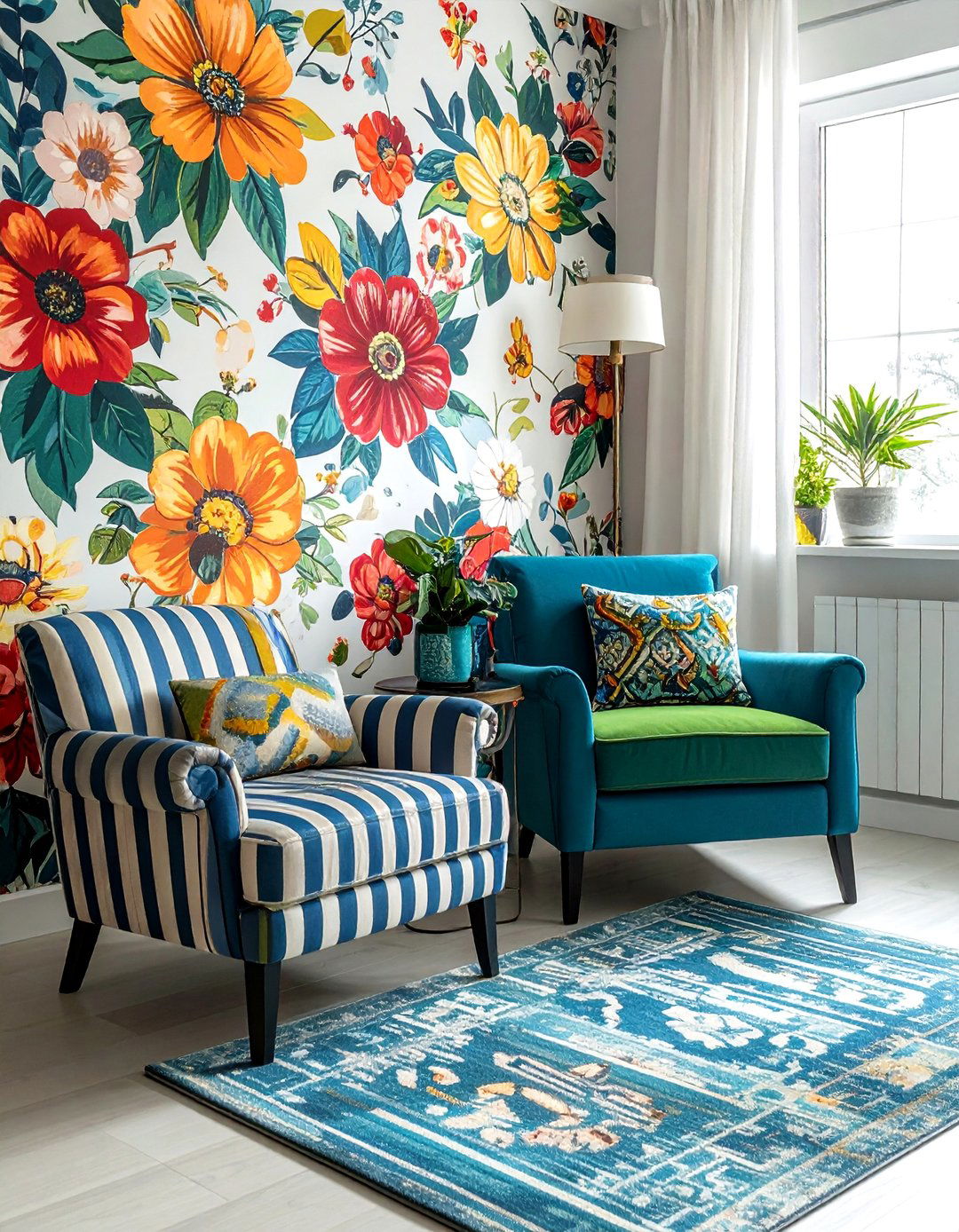
Embrace one of the most daring aspects of eclectic design: mixing patterns. A thoughtfully executed pattern play can create a room that is vibrant, energetic, and full of personality. Start by choosing a large-scale pattern for a significant element, like a bold floral wallpaper on an accent wall. Then, introduce smaller-scale patterns through textiles like curtains, throw pillows, and upholstery. To ensure harmony, select patterns that share a common color palette. For example, a geometric rug, striped chairs, and a damask cushion can all work together beautifully if they all contain shades of the same blue. This layering creates visual richness and depth.
20. Establishing Cohesion with a Single Unifying Color Thread

In a room filled with diverse furniture, art, and decor, a single, consistent color can serve as the thread that ties everything together. Choose one strong accent color and strategically repeat it throughout the space. This could be a specific shade of teal, magenta, or sunny yellow. Use it in various elements—a piece of art, a throw pillow, a vase, the pattern on a rug, or even a single piece of furniture. This repetition creates a visual pathway for the eye, guiding it through the room and making the collection of disparate items feel intentional and connected, providing order amidst the delightful variety.
21. Arranging Eclectic Dining Rooms with Mismatched Chairs

An easy yet highly effective way to introduce eclectic charm into your dining room is by surrounding the table with a collection of mismatched chairs. This look breaks the mold of traditional, uniform dining sets and adds instant character and a relaxed, informal feel. You can collect chairs of different styles, materials, and eras—a modern ghost chair next to a rustic farmhouse stool and a classic upholstered armchair. To create a sense of cohesion, you can paint all the chairs the same color, or ensure they are all of a similar height to provide comfort for your guests.
22. Curating Personal Heirlooms and Nostalgic Objects

An eclectic home should be a reflection of your personal history. Make space for cherished family heirlooms and nostalgic objects that hold sentimental value. Your grandmother's antique vanity, a set of hand-painted plates from a relative, or your childhood collection of vintage toys can become meaningful focal points. Instead of storing these items away, integrate them into your decor. Display them prominently on shelves, a mantelpiece, or side tables. These pieces bring a sense of soul and history to your space, ensuring your home is not just stylish but also deeply personal and filled with meaningful connections to your past.
23. Leveraging Negative Space to Highlight Key Pieces
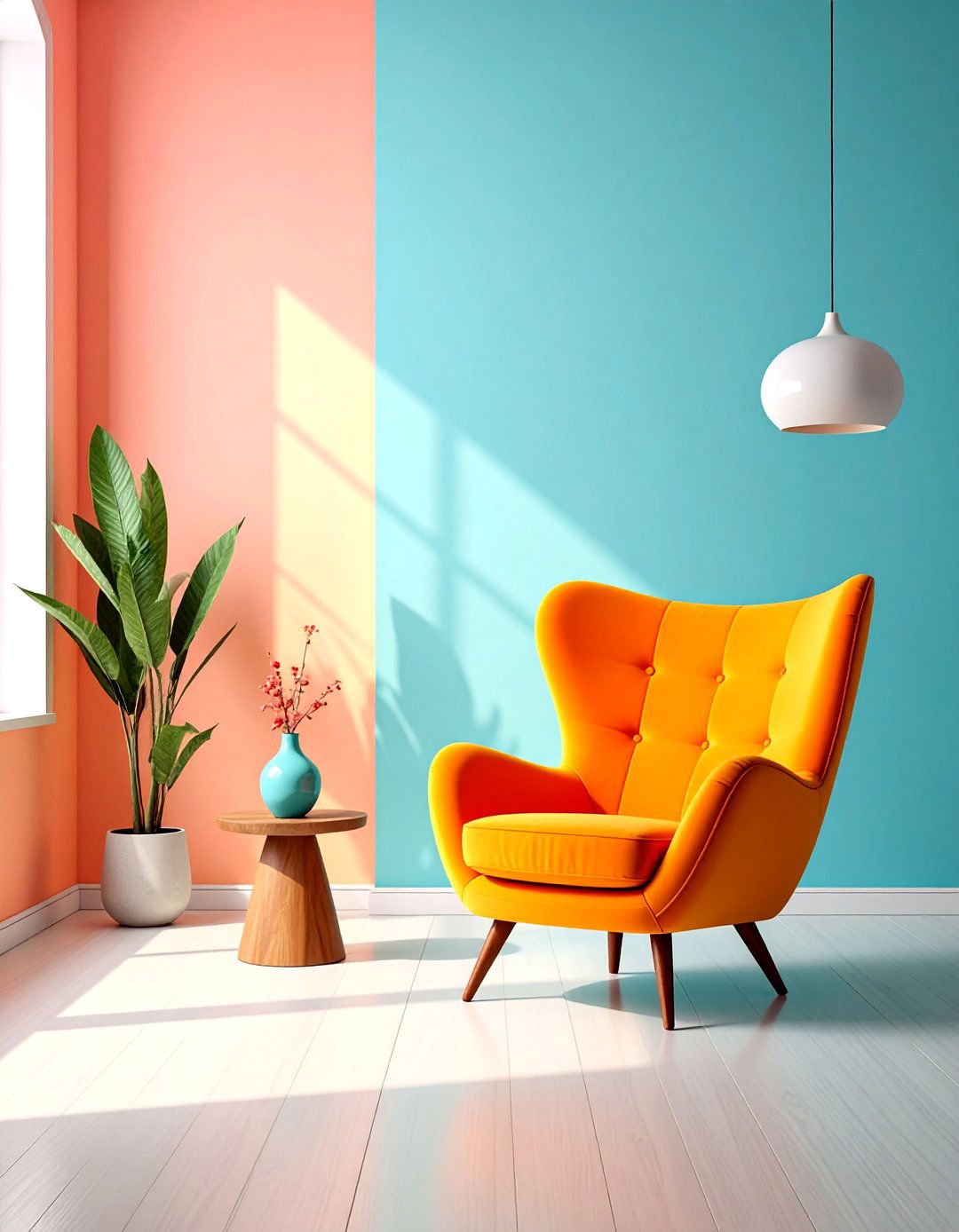
In an eclectic interior, what you don't include is just as important as what you do. While the style can lean towards maximalism, incorporating negative space—or empty areas—is crucial for avoiding a cluttered feel. Deliberately leaving a wall partially bare or ensuring there is ample room around a statement piece of furniture allows that item to breathe and be fully appreciated. This visual pause helps to highlight the unique shape, color, or texture of your curated selections. By balancing your collection with areas of rest, you create a more sophisticated and impactful design that feels curated rather than chaotic.
24. Designing Eclectic Bathrooms with Unique Tilework
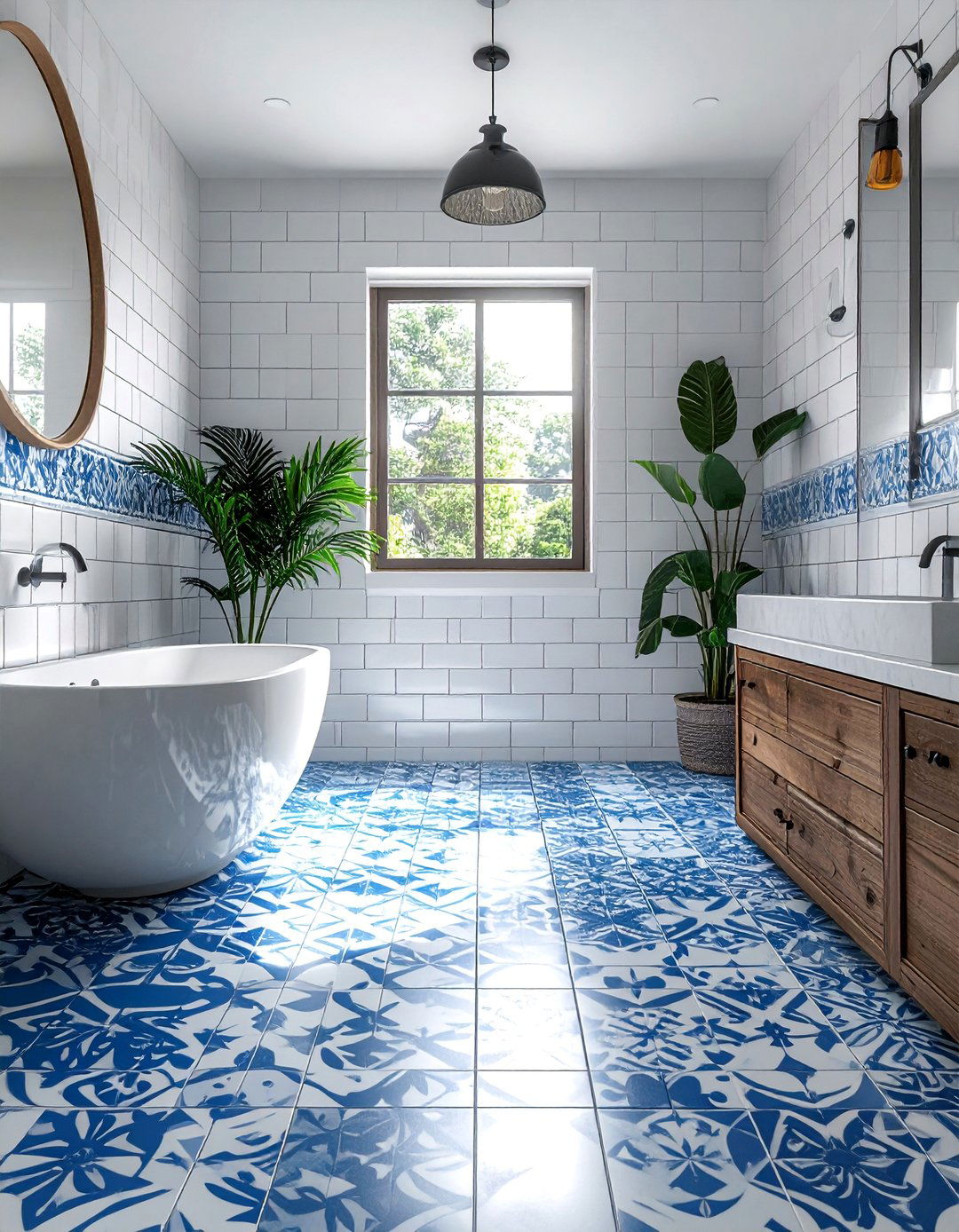
Transform a utilitarian bathroom into an eclectic sanctuary with bold and unique tile choices. Mix and match different tile patterns, shapes, and colors to create a truly one-of-a-kind space. Consider a vibrant, patterned cement tile on the floor paired with a classic white subway tile on the walls, perhaps with a contrasting grout color. You could also create a feature wall in the shower with iridescent mosaic tiles or uniquely shaped hexagonal tiles. This focus on tilework adds a powerful layer of texture and personality, turning the bathroom into a jewel box of design that reflects the adventurous spirit of eclecticism.
25. Highlighting Architectural Details as a Foundational Element

Use your home's existing architectural features as the foundation for your eclectic design. If you have elements like ornate crown molding, an original fireplace, or beautiful exposed beams, make them a central part of your scheme. Juxtapose these traditional details with modern furniture and contemporary art to create a compelling contrast between the old and the new. For example, hang an abstract, minimalist painting above a detailed antique fireplace mantel. This honors the history and character of the space while infusing it with your own modern, eclectic personality, creating a rich and layered interior that feels both timeless and current.
Conclusion:
Eclectic interior design is ultimately a celebration of individuality and creative freedom. It's about breaking free from rigid rules and crafting a space that tells your personal story through a curated mix of styles, eras, and cultures. By balancing bold choices with unifying elements like color, texture, and scale, you can create a home that is not only visually captivating but also deeply authentic. The key is to trust your instincts, choose pieces you love, and arrange them in a way that feels harmonious and uniquely you, resulting in a space that is both cohesive and full of life.



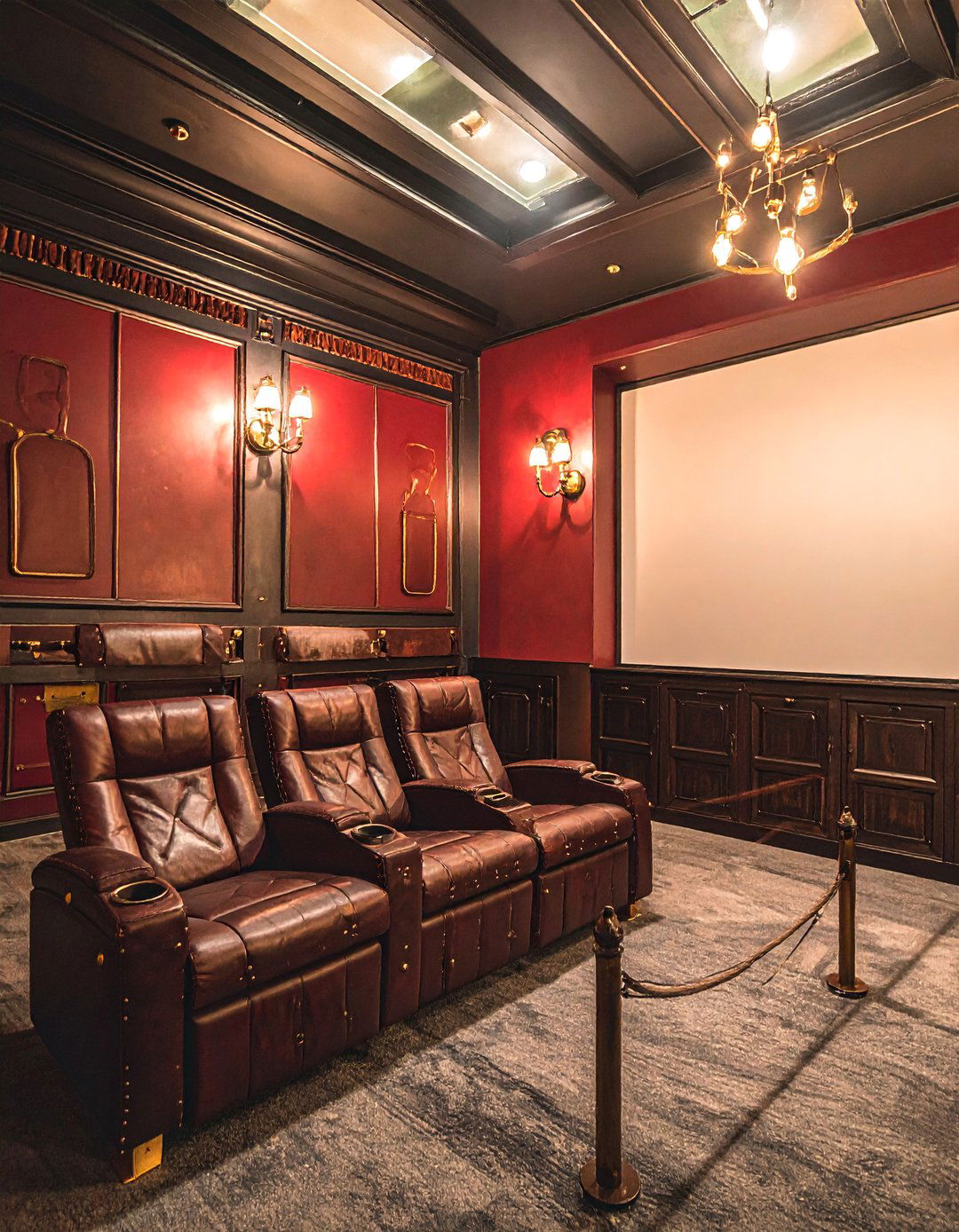

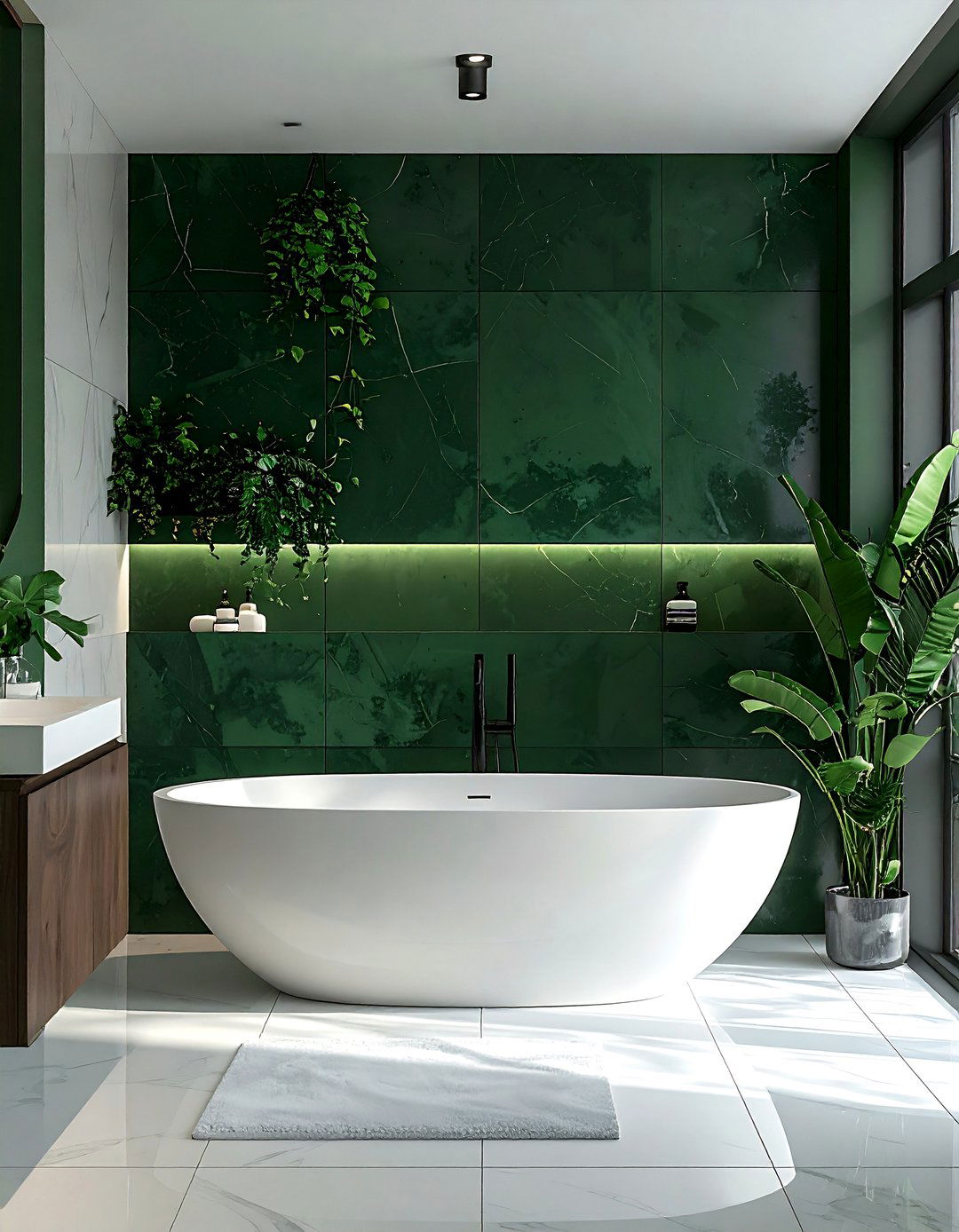



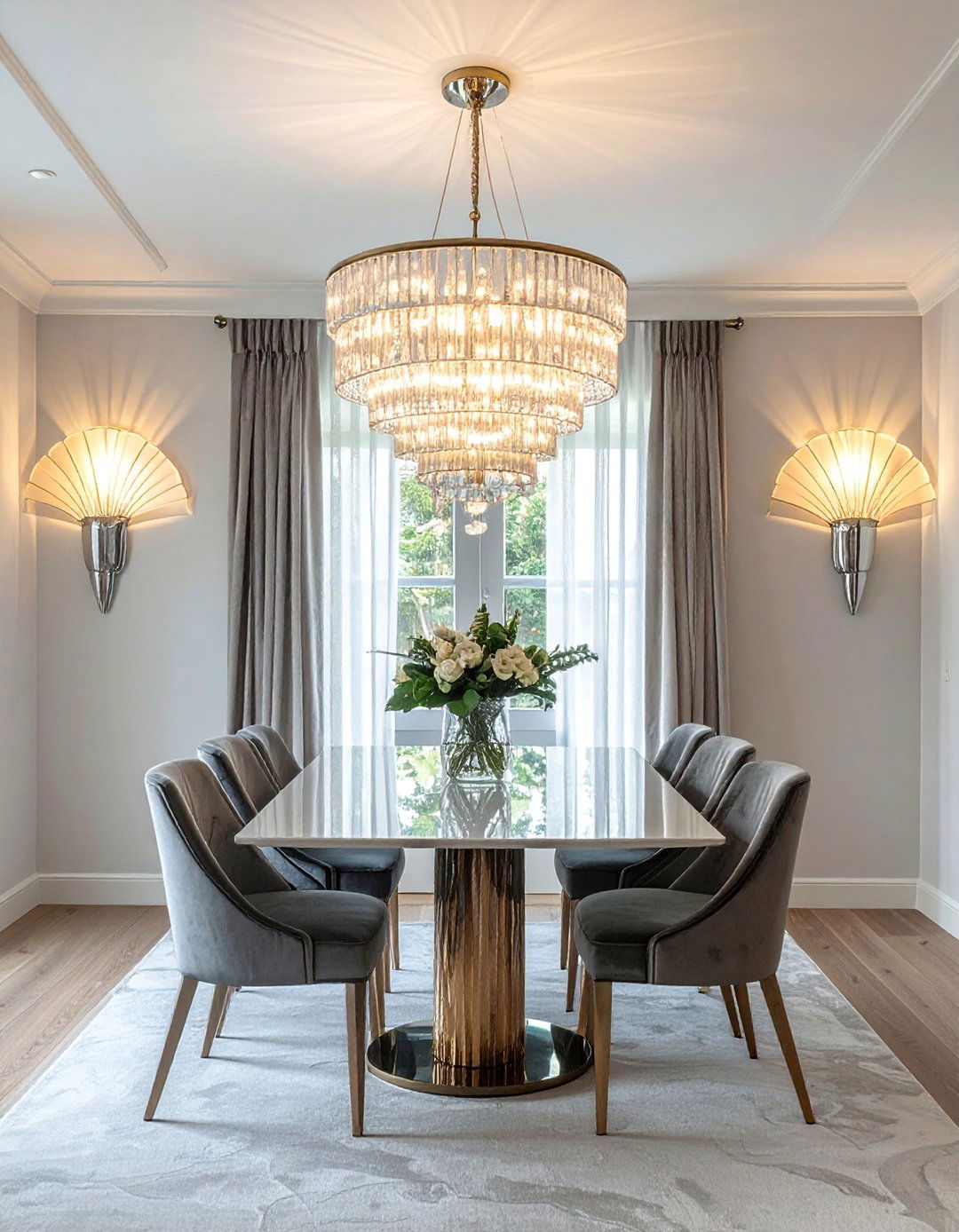

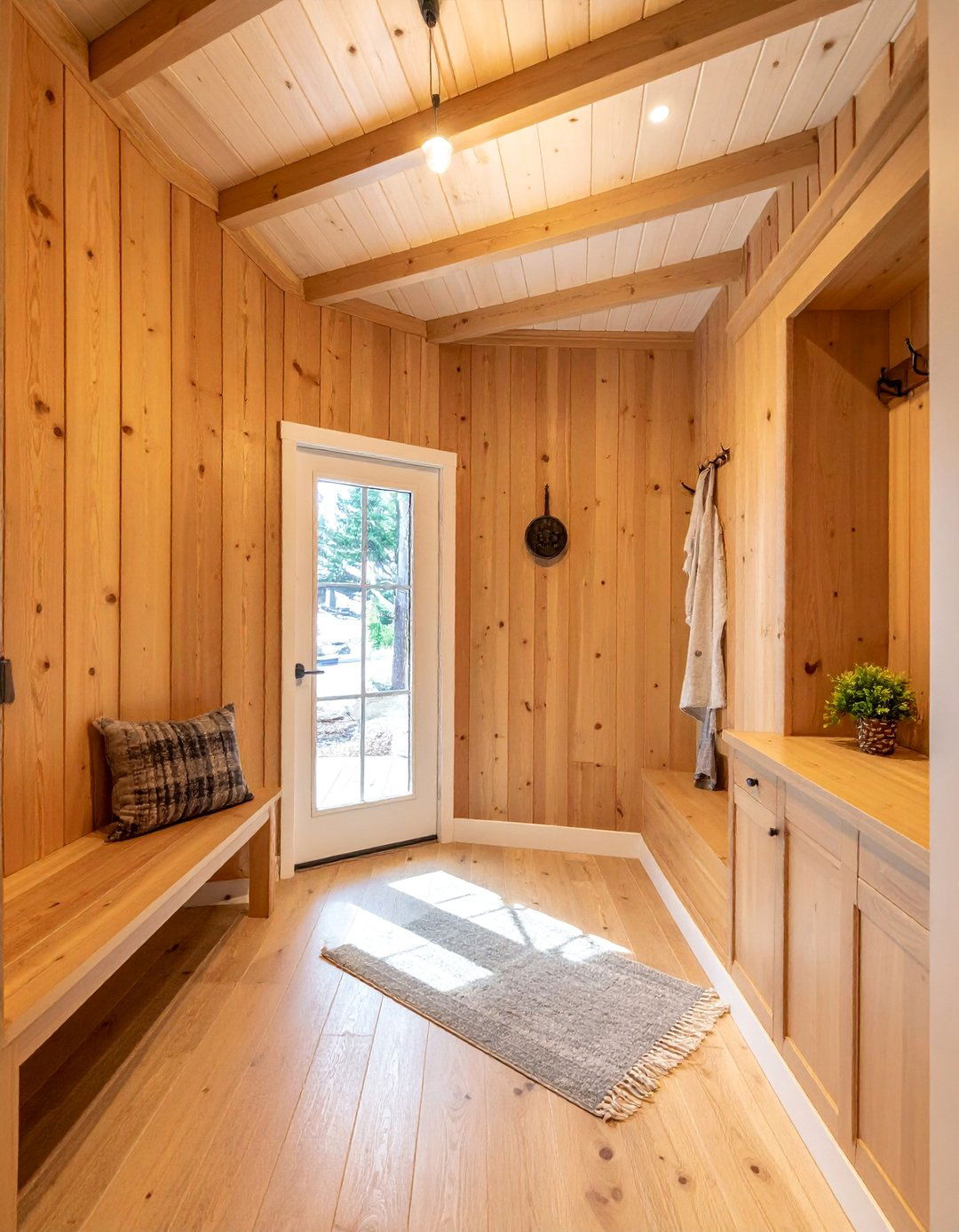
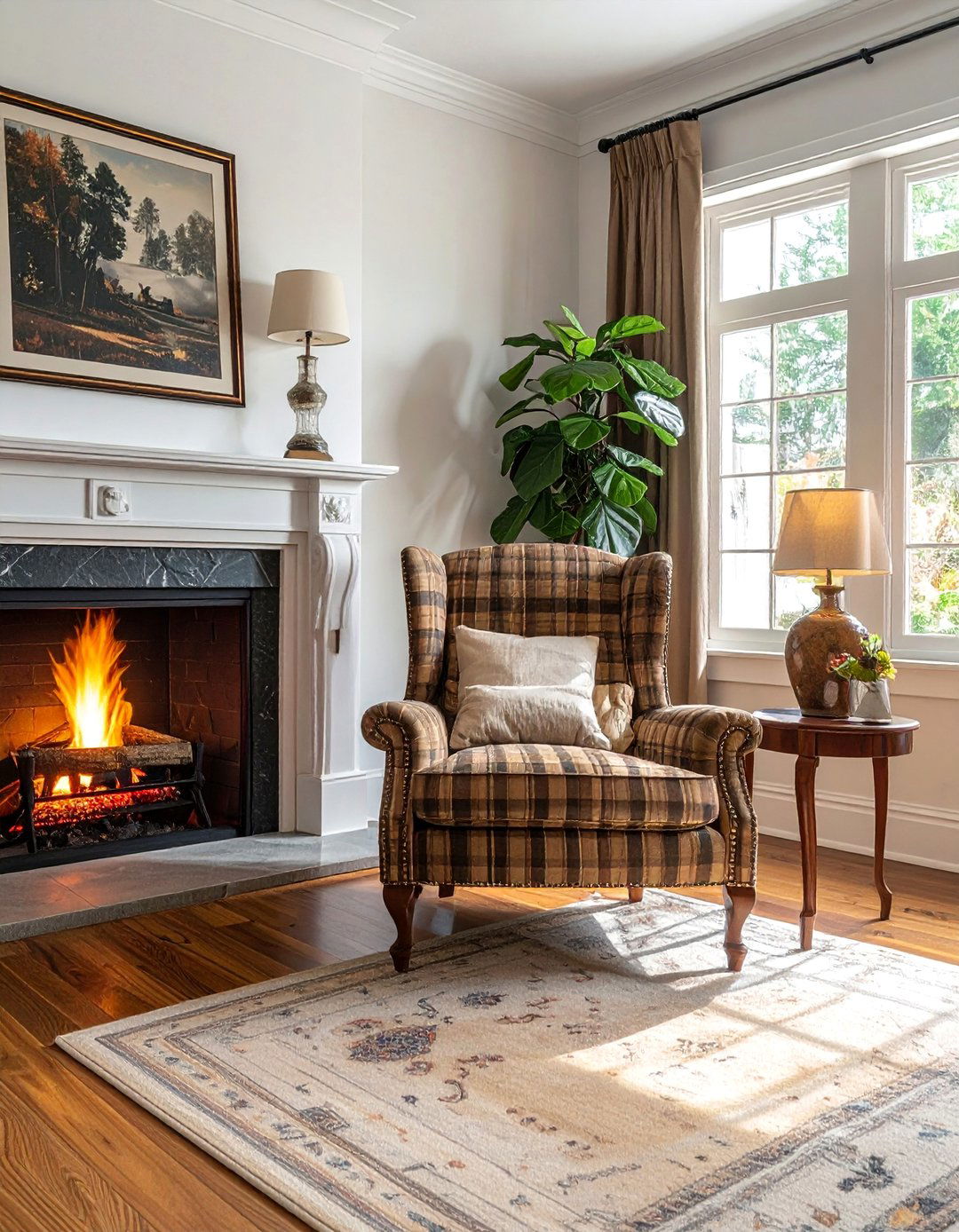
Leave a Reply